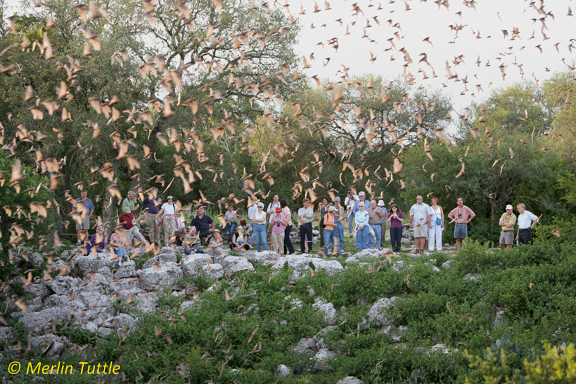Tracking the Impacts of WNS at Wisconsin’s Stonefield Historic Site
“Just like the old days, eh Heather?” Kent softly clicks his tally counter as he sits in his folding chair on the other side of
Case Closed–No further action needed.
Subsequent stories about bats have been mostly positive. Thank you Bat Fans for your participation. May 24, 2016
A growing avalanche of needlessly scary media stories threatens to undo decades of bat conservation progress. The most recent example, Lurking in the Shadows, by Bob Grant appeared in the December 1, 2014 issue of TheScientist. Without our clear and prompt protests, such misinformation will continue to circulate till, with sufficient repetition, it becomes “fact” in the public mind. And people who fear bats typically turn from conserving to killing. Here is Merlin’s response.
“Your article, Lurking in the Shadows, by Bob Grant, is full of speculation about bats as potential sources of dread diseases while ignoring the outstanding safety record of bats living near people. I am just one of hundreds of biologists who have worked in very close association with bats, and despite spending countless thousands of hours with them on every continent where they exist, none of us has contracted one of these so-called emerging diseases, nor is there any evidence that even the largest aggregations of bats living in cities have caused public health problems.
Your article includes a photo of 1.5 million free-tailed bats emerging from the Congress Avenue Bridge in downtown Austin, Texas, but fails to mention that, despite early warnings from health officials, not a single one of the millions of visitors who have enjoyed close-up observations of these bats over the past 35 years has contracted a disease from them.
Unfortunately, as recently noted in Rick Steves’ Los Angeles Times Op-Ed, news media are increasingly relying on scare tactics to boost ratings that turn profits. The same appears to be true for at least a few virologists who have learned that scaring people about bats is far more lucrative (in gaining grants) than helping people overcome unfounded fears of little known, but invaluable creatures of the night. As Steves noted, “We end up being afraid of things we shouldn’t be—and ignoring things that actually do threaten our society.”
Incidentally, there appears to be overwhelming evidence that the Middle East respiratory syndrome coronavirus (MERS-CoV), attributed to be of bat origin in your story, is actually far more closely linked to camels. Since less than one percent of viruses have yet been taxonomically described, it is easy to find new ones wherever we look. Focusing disproportionate attention on bats isn’t likely to make us any safer, though it is perhaps tempting to divert our attention to rare diseases instead of dealing with the real public health killers we’d prefer to ignore.” Merlin Tuttle
You do not need to be an expert to respond. Editors are hired and fired based on readership sales. You need only to express your strong displeasure regarding this kind of reporting to make a difference. You additionally can help by calling our attention to such articles as they appear. We will do our best to respond promptly and alert others to do the same.
For the latest scientific information on MERS go to http://mbio.asm.org/content/5/2/e00884-14.full and http://mbio.asm.org/content/5/3/e01146-14.full. Also note the “Articles citing this article” section at the end of each of these publications. For information useful in evaluating future stories go to the Get Involved section on this website.

Love our content? Support us by sharing it!
“Just like the old days, eh Heather?” Kent softly clicks his tally counter as he sits in his folding chair on the other side of
An important new study, recently published in Science and widely covered by major newspapers like The Guardian, The Washington Post, and The New York Times, has
On March 6, 2024, the Wall Street Journal presented findings from the University of Leeds in their opinion piece, “Why Scientists Love Chasing Bats; The
Response to Misleading Scientific American Bat Story I am responding to the article titled, “A Secret Weapon in Preventing the Next Pandemic: Fruit Bats,” which
2024 © Merlin Tuttle’s Bat Conservation. All rights reserved.
Madelline Mathis has a degree in environmental studies from Rollins College and a passion for wildlife conservation. She is an outstanding nature photographer who has worked extensively with Merlin and other MTBC staff studying and photographing bats in Mozambique, Cuba, Costa Rica, and Texas. Following college graduation, she was employed as an environmental specialist for the Florida Department of Environmental Protection. She subsequently founded the Florida chapter of the International DarkSky Association and currently serves on the board of DarkSky Texas. She also serves on the board of Houston Wilderness and was appointed to the Austin Water Resource Community Planning Task Force.
Michael Lazari Karapetian has over twenty years of investment management experience. He has a degree in business management, is a certified NBA agent, and gained early experience as a money manager for the Bank of America where he established model portfolios for high-net-worth clients. In 2003 he founded Lazari Capital Management, Inc. and Lazari Asset Management, Inc. He is President and CIO of both and manages over a half a billion in assets. In his personal time he champions philanthropic causes. He serves on the board of Moravian College and has a strong affinity for wildlife, both funding and volunteering on behalf of endangered species.